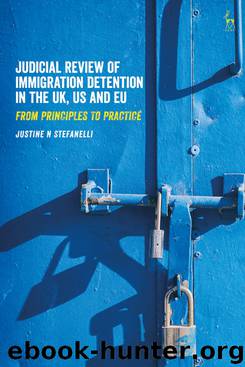Judicial Review of Immigration Detention in the UK, US and EU by Justine N Stefanelli

Author:Justine N Stefanelli [Stefanelli, Justine N]
Language: eng
Format: epub
Tags: Migration
Publisher: Bloomsbury Publishing
Published: 2020-01-22T23:00:00+00:00
A.United Kingdom
Chapter three illustrated the way in which a computer algorithm is used in the USA to predict risk of future criminality at the point of the initial decision to detain. Interestingly, the UK analyses risk using a similar method, the Offender Assessment System (OASys), but in contrast to the USA, OASys is only used in connection with criminal offenders and is not meant to function as the main risk assessment tool for immigration authorities. The role of OASys reports in assessing risk in the context of immigration detention was addressed by the Administrative Court in JM, where the Court stated that:
[the Secretary of State] has to have careful regard to the OASys assessments, in accordance with her policy. Nonetheless she was required to bring her own judgment to bear upon the facts in any particular case. The OASys is an assessment tool, designed for use by the decision maker, along with other information. It is necessarily mechanistic. It is not a substitute for an exercise of judgment by the decision maker, whether that is a sentencing judge or an immigration official.106
A High Court judge confirmed this perspective when I asked him about the role that such reports play in assessing risk. He noted that they are one factor among many others, including whether and to what extent completing a criminal sentence may have positively affected the individual in question, and that individual’s feelings about his or her experience in prison.107 He also indicated that the weight of an OASys report will decrease the older it is.108
Chapter 55 of the EIG, discussed in chapter three above, states that ‘public protection is a key consideration underpinning … detention policy’.109 It requires initial detention decision makers (ie immigration officials) to consider whether the presumption in favour of bail outweighs the risk of harm to the public and instructs them to look at all relevant factors. It also stipulates that convictions for serious offences are ‘strongly indicative of the greatest risk of harm to the public and a risk of absconding’, and that therefore the ‘high risk of public harm carries particularly substantial weight when assessing if continuing detention is reasonably necessary and proportionate’.110
While this may be going on at the administrative level, there is no explicit evidence that the Administrative Court is undertaking the same review. However, there is evidence that the Court considers any risk of reoffending or dangerousness in light of ‘the breach of the principle of liberty’, and in doing so considers a range of relevant factors.111 Indeed, I observed arguments at the Administrative Court where the judge lamented the failure of the Immigration Act to properly account for the potential of an individual’s risk level to change over time, and admonished the Secretary of State for basing its risk assessment on a nine-year-old determination by another decision maker that the individual presented a danger.112 Beyond that, the case law provides several examples of the judges balancing the severity of the offence with when it occurred. In doing so, they remind the parties that no single factor operates as a ‘trump card’.
Download
This site does not store any files on its server. We only index and link to content provided by other sites. Please contact the content providers to delete copyright contents if any and email us, we'll remove relevant links or contents immediately.
Killers of the Flower Moon by David Grann(3761)
Machine Learning at Scale with H2O by Gregory Keys | David Whiting(3664)
Oathbringer (The Stormlight Archive, Book 3) by Brandon Sanderson(2660)
Will by Will Smith(2595)
Once Upon a Broken Heart by Stephanie Garber(2537)
Guns, Germs and Steel by Diamond Jared(2206)
Borders by unknow(2122)
It Starts With Us (It Ends with Us #2) by Colleen Hoover(2059)
The Room Where It Happened by John Bolton;(2037)
Friends, Lovers, and the Big Terrible Thing by Matthew Perry(2018)
The Color of Law by Richard Rothstein(1824)
HBR's 10 Must Reads 2022 by Harvard Business Review(1703)
The Strength In Our Scars by Bianca Sparacino(1702)
A Short History of War by Jeremy Black(1679)
Water Rights and the Environment in the United States by John Burch(1607)
Examples & Explanations: Administrative Law by William F. Funk & Richard H. Seamon(1555)
515945210 by Unknown(1525)
Pharmacy Practice and The Law by Richard Abood(1497)
That Every Man Be Armed by Stephen P. Halbrook(1481)
